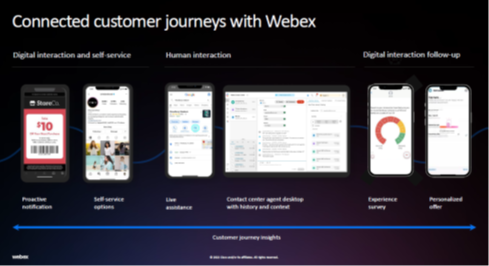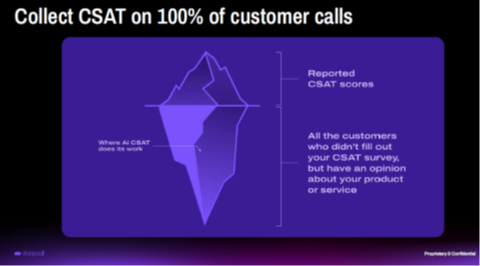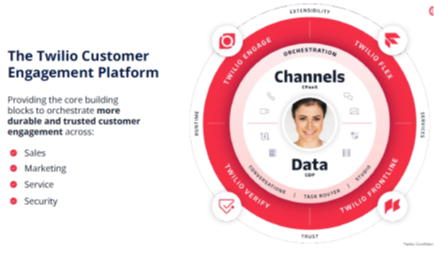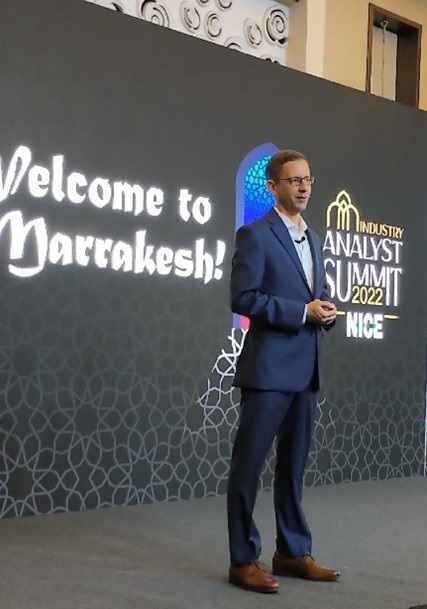For analysts, the past few weeks have been a blur of industry events, and our travel schedules have never been busier. Vendors are trying to make up for lost time after a three-year hiatus from in-person events, and every week there’s another event or two to fly to. The benefit for No Jitter readers is getting my first-hand account of what some of the vendors are doing, neatly summarized.
For this post, I’m going to focus on how vendors are working artificial intelligence (AI) into their CCaaS offerings. AI is everywhere now, but the use cases are particularly strong in the contact center. Not only are contact centers accelerating efforts to adopt the cloud to modernize, but they’re looking to AI for service automation, as well as enabling them to leverage the massive streams of data that come with today’s digital customer experience (CX).
So much to talk about and so little time. This post is just a snapshot of what some vendors are doing now. Each one merits its own writeup, and other vendors have good stories to tell as well. All things in good time, and for now, here’s a roundup on the state of AI in the contact center based on my recent travels.
Cisco Webex Contact Center
Collaboration seems to get all the attention in the world of Webex but the contact center – along with CPaaS – are important parts of Cisco's whole. Contact center vendors all have a similar narrative in terms of helping customers manage the digital customer journey. I like Cisco’s messaging: The company talks about the connected journey, and how it’s more than just when customers start engaging with a chatbot or an agent.
It’s really about anticipating customer intent and addressing it intelligently across the entire customer journey. As such, before the initial customer engagement happens, Cisco's AI tools now play a key role by pulling together relevant data about the customer, along with analyzing intent from the initial inquiry so that, depending on the context, the customer's query can be intelligently routed to a bot or an agent with the right expertise. When done well, the experience can be magical, as the customer can hit the ground running rather than explaining a long leadup to an agent.
The connected journey continues after the inquiry, such as polls or surveys to collect CSAT data, confirmation notices, or reminder alerts. Not only does this tie off an end-to-end customer experience, but by using predictive analytics from this journey, highly customized offers can be pushed out to drive new purchases.
Cisco's narrative is less about specific technologies and more about understanding how CX is different today and is driven by digital transformation. AI is a key enabler to help businesses harness all this new data and apply it intelligently. The first step is for vendors is to get contact centers thinking about intelligent data application, and only then do the technology conversations begin. That’s why this narrative is so important, and I think Cisco is telling it very well.
When positioned this way, Cisco asks the logical question: “So what’s holding you back?” Not surprisingly, they have found that customers don’t know where to start, so there’s a lot of inertia – or even paralysis – that keeps contact center leaders from taking that all-important first step. The connected journey is a pretty good place to start and based on the performance metrics they shared with us—this approach is working pretty well for Cisco.
Dialpad Agent Empowerment
Dialpad hasn’t had any analyst events lately, but I’ve been briefed a few times recently, and its AI story for the contact center is consistent with their peers' narratives. Dialpad has done a good job branding with Ai Agent Assist, Ai QA Scorecards and Ai CSAT being the core pieces. The first thing to note is that Dialpad owns all the pieces in its platform, so integrating CCaaS with UCaaS is not an issue, and it has full control over how the platform evolves.
The AI piece is mostly about providing real-time input—both for agents and supervisors—to handle every inquiry in the moment. With Agent Assist, the agent can speak or type a request, such as “I need an expert for our premium offering in the EU market”, and the response will come right away, so the agent doesn’t keep the customer waiting. Furthermore, the AI piece means that a knowledge base gets built over time, so Agent Assist can handle more complex inquiries. Furthermore, it will come to “know” the agent’s intent, so only a few keywords need to be entered, speeding up the process.
Similarly, AQ Scorecards can track all interactions – not just a random subset – and alert supervisors for outliers that may need their attention. This could either be positive or negative interactions, where AI reads sentiment – both for agents and customers. For now, the capabilities may be fairly basic, but as with all things AI, Scorecard becomes more accurate over time, enabling supervisors to respond more effectively to changes in sentiment.
Ai CSAT may be the boldest part of Dialpad’s story, in the CSAT “scores” are inferred rather than based on actual survey data from customers. This requires putting a lot of faith in AI to associate likely outcomes based on sentiment and inferred intent, and it’s too early to tell how well this will align with actual behaviors. However, there is an attractive trade-off here, as Ai CSAT can be applied to every interaction with every customer, and in time, this will produce a massive trove of data that can be fine-tuned to reflect the impact of every interaction between agents and customers. You might not have this much faith in AI yet, but the aspirations are sound in terms of what’s possible with AI in the contact center.
Twilio Flex
Speaking of outliers, Twilio’s place in the customer service arena has always been difficult to understand, at least from the inside, where the problem set has been approached with long-standing technology. That’s both the problem and the solution, as Flex takes a different approach, one that’s digital-native and cloud-first. Most contact center vendors don’t have that pedigree, not to mention the DNA of a platform built for messaging, a channel that has only recently become important for customer service.
To make that point clear, CEO Jeff Lawson wasted little time explaining that last year, companies spent $69 billion on CRM, yet only 13% of customers report having a great CX. Of course, customer relationship management (CRM) is just one factor here, but these data points imply that a lot of money is being spent in the wrong places. Given how quickly technology is evolving, that’s a fair statement, and my earlier reference to inertia applies here too. Some contact center leaders are too risk-averse to make any big moves, but others see where new forms of customer engagement are happening, and in many cases, something different like
Twilio Flex is the way to go.
As Lawson noted, “the name of the game is turning transactions in to relationships,” and “digital execution” is how today’s leaders like Amazon and Netflix differentiate. Customer experience is how this translates for contact centers, but as Twilio is showing, CX goes beyond the contact center. Much of its success come from other lines of business, especially marketing and sales, where engagement is more about acquiring customers than keeping them happy. Both are incredibly important, and that’s what makes this problem set a C-suite buying decision, at least for Twilio.
That’s the thinking behind CEP – Customer Engagement Platform – where all the core elements of Twilio’s business intersect, namely CPaaS, CDP (Customer Data Platform) and Flex. Data is at the heart of Twilio's platform, and it’s all driven by AI. Each of these generates massive amounts of data, and the key here is to orchestrate all of it at scale, and that’s where AI comes in. There’s much more ground to cover here, but the main takeaway is that Twilio’s AI story isn’t about specific features like real-time translation, but rather on a higher level that allow companies to engage with customers – and prospects – head-on, so transactions can be turned into relationships.
NICE and Suiteform
Another day, another new term, but this one–suiteform– fits my roundup. I’ll explain that term in a moment. But first, I want to note that NICE is framing the AI narrative at a higher, perhaps more ambitious level, than what most other vendors are doing in this space. Most of the talking points from the vendor events around AI and the contact center have been on the details and all the wonderful new features. We definitely need that, but NICE’s CEO, Barak Eilam, is more interested in the bigger picture and what all these transformative changes mean. He talked about the “AI-ization” of things to help manage the complexity of our modern, hyperconnected lives.
Data seems to be infusing everything now, and humans have limited capacity to make sense of it all. The more we crave connectivity, the messier our lives become, and reducing the mess while maintaining the connectivity is the higher calling that AI can serve—presuming it’s in the right hands. NICE’s messaging is about how they are one of those right hands, at least when it comes to CX.
Rather than focus on AI-driven features, Eilam is trying to elevate the whole CCaaS space to address CX in this emerging world. CXone is their full suite of CCaaS capabilities, but it’s not the whole story. CCaaS is a key piece, but for NICE, digital CX is also about journey orchestration, smart self-service, and mapping workflows across all digital entry points for customers – not just those to the contact center.
This calls for a platform-based approach, which is the essence of any cloud provider. The takeaway here is to view NICE as a platform that is more than a CCaaS product suite, hence “suiteform.” I am not sure if this term will ever catch on, but it reflects a broader form of thinking that may be beyond how contact center leaders are currently looking at the problem set.
As NICE CXOne CEO Paul Jarman noted, only 19% of customer interactions are directly with agents now, and 81% are coming indirectly via digital channels. Unless your CCaaS platform is truly digital-first, thinking about CX in terms of CCaaS alone is only going to hit a small part of the target.
Enlighten AI is the company's AI story, and it covers similar ground to what other leading contact center vendors are doing. In the spirit of Barak’s messaging, those details aren’t important here – AI is a given for any modern approach to CX. You may not be ready to tag suiteform on social media yet, but if you’re not thinking along these lines, you’re only seeing part of the bigger picture.
This post is written on behalf of BCStrategies, an industry resource for enterprises, vendors, system integrators, and anyone interested in the growing business communications arena. A supplier of objective information on business communications, BCStrategies is supported by an alliance of leading communication industry advisors, analysts, and consultants who have worked in the various segments of the dynamic business communications market.















